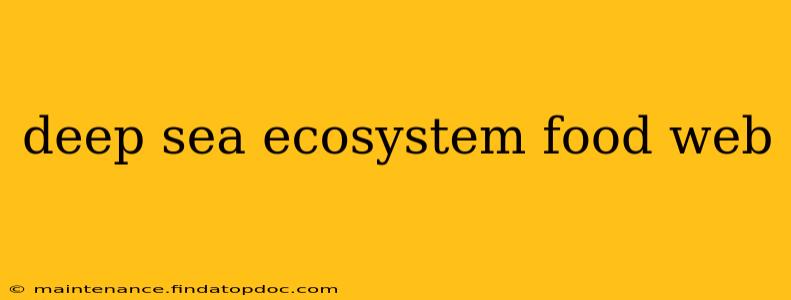The deep sea, a realm of perpetual darkness and crushing pressure, harbors a surprisingly diverse and complex ecosystem. Understanding its intricate food web is crucial to appreciating the delicate balance of this unique environment and the challenges it faces. Unlike shallower waters, the deep sea food web relies less on sunlight and more on a constant rain of organic matter from above, a process that shapes the entire ecosystem.
What is the base of the deep sea food web?
The foundation of the deep-sea food web isn't photosynthesis, like in shallower waters. Instead, it relies heavily on marine snow. This continuous shower of organic debris – dead organisms, fecal matter, and other organic particles – sinks from the surface waters. This sinking material provides the primary energy source for the deep-sea community. Chemosynthesis, a process where organisms derive energy from chemicals rather than sunlight, also plays a vital role, particularly around hydrothermal vents and cold seeps. These unique ecosystems support thriving communities independent of sunlight.
What are the primary consumers in the deep sea?
The primary consumers, or those that feed directly on marine snow or chemosynthetically-produced matter, are incredibly diverse. They include:
- Suspension feeders: These organisms, like certain types of sponges and corals, filter microscopic particles from the water column, consuming the organic matter within the marine snow.
- Deposit feeders: Creatures like sea cucumbers and certain worms ingest sediment, extracting organic matter from the particles.
- Scavengers: Deep-sea amphipods and isopods are vital scavengers, consuming the carcasses of larger animals that sink to the depths. These are crucial for nutrient cycling in the deep sea.
What are the secondary and tertiary consumers in the deep sea?
The secondary and tertiary consumers in the deep sea are predominantly predatory. This includes:
- Fish: Many deep-sea fish, such as anglerfish and viperfish, are highly specialized predators with bioluminescent lures to attract prey in the darkness.
- Cephalopods: Giant squid and other deep-sea cephalopods are apex predators, feeding on fish and other invertebrates.
- Crustaceans: Large predatory crustaceans, such as deep-sea shrimps and crabs, play a significant role in the food web, preying on smaller organisms.
How does the deep sea food web differ from other ecosystems?
The deep-sea food web fundamentally differs from those in shallower waters due to the absence of sunlight. The reliance on marine snow and chemosynthesis creates a food web based on a different energy source. The lower energy input results in a slower metabolism and slower growth rates in deep-sea organisms compared to their shallower counterparts. Additionally, the pressure and extreme environmental conditions select for specialized adaptations, such as bioluminescence and pressure-resistant bodies.
What are some of the challenges facing the deep sea food web?
The deep-sea ecosystem, while seemingly remote, is vulnerable to human impacts. These include:
- Overfishing: Bottom trawling can disrupt the seafloor habitat and deplete populations of deep-sea organisms.
- Pollution: Plastic debris and other pollutants can accumulate in the deep sea, affecting the food web through ingestion and habitat degradation.
- Climate change: Changes in ocean temperature and acidity can alter the distribution and abundance of deep-sea organisms.
What are the key organisms in the deep sea food web?
The key organisms span multiple trophic levels, from the microscopic bacteria driving chemosynthesis to the large predatory fish and squid at the top. The specific organisms vary depending on the location and specific deep-sea habitat (e.g., abyssal plains, hydrothermal vents). However, a constant theme is the adaptation to the extreme pressure, cold, and darkness of this environment. Organisms like giant tube worms at hydrothermal vents and the diverse community surrounding them are prime examples of specialized deep-sea keystone species.
How does the deep sea food web impact other ecosystems?
While seemingly isolated, the deep sea interacts with other marine ecosystems. The sinking of organic matter from surface waters fuels the deep-sea food web. Conversely, changes in deep-sea ecosystems, like disruptions from bottom trawling, can impact the overall ocean health and biodiversity.
Understanding the deep sea food web is crucial for conservation efforts. Protecting this fragile ecosystem requires a comprehensive approach considering both the direct and indirect human impacts on this unique and vital part of our planet. Further research into the complex interactions within this environment is essential for its long-term survival.
